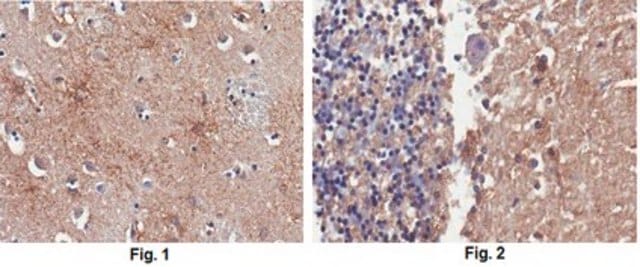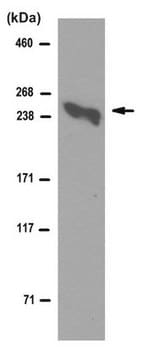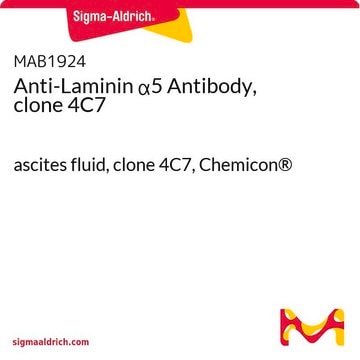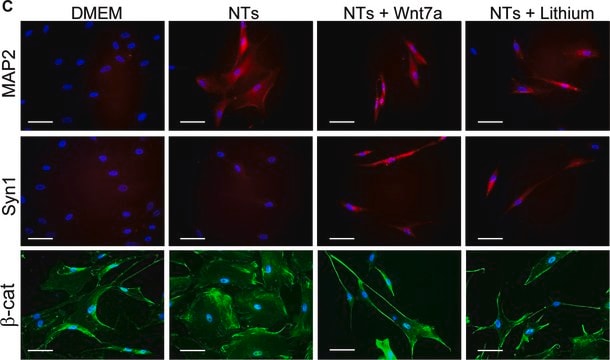MAB378
Anti-MAP2A Antibody, AP20
ascites fluid, clone AP20, Chemicon®
Synonim(y):
Microtubule Associated Protein 2
About This Item
Polecane produkty
pochodzenie biologiczne
mouse
Poziom jakości
forma przeciwciała
ascites fluid
rodzaj przeciwciała
primary antibodies
klon
AP20, monoclonal
reaktywność gatunkowa
quail, bovine, human, mouse, amphibian, Xenopus, rat, avian
producent / nazwa handlowa
Chemicon®
metody
immunohistochemistry: suitable
western blot: suitable
izotyp
IgG1
numer dostępu NCBI
numer dostępu UniProt
Warunki transportu
dry ice
docelowa modyfikacja potranslacyjna
unmodified
informacje o genach
human ... MAP2(4133)
Opis ogólny
MAP-2 is a stringent marker for neurons. In addition, MAP-2 displays intracellular specificity. In the central nervous system, MAP-2 is confined to neuronal cell bodies and dendrites. There are exceptions, however, where some axons stain positive for small amounts of MAP-2 (Caceres, 1984; Binder, 1986). MAP-2 is uniformly distributed throughout the cell when first expressed in cultured neurons but becomes selectively localized as dendritic development proceeds (Caceres, 1986; Dotti, 1987).
Specyficzność
Immunogen
Zastosowanie
1:50-1:200. AP20 stains dendrites and neuron cells bodies but not neuronal processes and axons. A previous lot of this antibody was used in immunohistochemistry.
Western blot:
SDS-PAGE Profiles: In SDS-PAGE MAP-2 from adult rat migrates as a closely associated doublet having a molecular weight of approximately 300 kD. However, early in brain development (postnatal day 10 in rats), MAP-2 migrates as a single band that is identical to the lower molecular weight band of the adult MAP-2 doublet (MAP-AP20). Later in development (postnatal days 17-18), the mobility of MAP-2 changes to the adult doublet form. (In the spinal cord, conversion to the adult form occurs earlier).
Western blot: A 1:500 dilution was used in a previous lot.
Optimal working dilutions must be determined by end user.
Neuroscience
Neuronal & Glial Markers
Neurofilament & Neuron Metabolism
Jakość
Western Blot Analysis:
1:500 dilution of this lot detected MAP 2 on 10 μg of PC12 lysates.
Opis wartości docelowych
Powiązanie
Postać fizyczna
Przechowywanie i stabilność
Handling Recommendations: Upon receipt, and prior to removing the cap, centrifuge the vial and gently mix the solution. Aliquot into microcentrifuge tubes and store at -20°C. Avoid repeated freeze/thaw cycles, which may damage IgG and affect product performance. Note: Variability in freezer temperatures below -20°C may cause glycerol containing solutions to become frozen during storage.
Komentarz do analizy
Brain tissue
Cultured neurons
Inne uwagi
Informacje prawne
Oświadczenie o zrzeczeniu się odpowiedzialności
Not finding the right product?
Try our Narzędzie selektora produktów.
polecane
Kod klasy składowania
12 - Non Combustible Liquids
Klasa zagrożenia wodnego (WGK)
nwg
Temperatura zapłonu (°F)
Not applicable
Temperatura zapłonu (°C)
Not applicable
Certyfikaty analizy (CoA)
Poszukaj Certyfikaty analizy (CoA), wpisując numer partii/serii produktów. Numery serii i partii można znaleźć na etykiecie produktu po słowach „seria” lub „partia”.
Masz już ten produkt?
Dokumenty związane z niedawno zakupionymi produktami zostały zamieszczone w Bibliotece dokumentów.
Nasz zespół naukowców ma doświadczenie we wszystkich obszarach badań, w tym w naukach przyrodniczych, materiałoznawstwie, syntezie chemicznej, chromatografii, analityce i wielu innych dziedzinach.
Skontaktuj się z zespołem ds. pomocy technicznej








